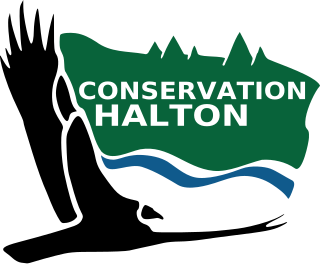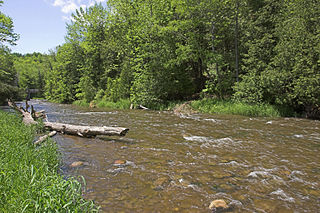
New Zealand is divided into sixteen regions for local government purposes. Eleven are administered by regional councils, and five are administered by unitary authorities, which are territorial authorities that also perform the functions of regional councils. The Chatham Islands Council is not a region but is similar to a unitary authority, authorised under its own legislation.

The Coastal Zone Management Act of 1972 is an Act of Congress passed in 1972 to encourage coastal states to develop and implement coastal zone management plans (CZMPs). This act was established as a United States National policy to preserve, protect, develop, and where possible, restore or enhance, the resources of the Nation's coastal zone for this and succeeding generations.
The Toronto and Region Conservation Authority (TRCA) is a conservation authority in southern Ontario, Canada. It owns about 16,000 hectares of land in the Toronto region, and it employs more than 400 full-time employees and coordinates more than 3,000 volunteers each year. TRCA's area of jurisdiction is watershed-based and includes 3,467 square kilometres (1,339 sq mi) – 2,506 on land and 961 water-based in Lake Ontario. This area comprises nine watersheds from west to east – Etobicoke Creek, Mimico Creek, Humber River, Don River, Highland Creek, Petticoat Creek, Rouge River, Duffins Creek and Carruthers Creek.
The Conservation Authorities Act was created by the Ontario Provincial Legislature in 1946 to ensure the conservation, restoration and responsible management of hydrological features through programs that balance human, environmental and economic needs. The Act authorizes the formation of Conservation Authorities on a per watershed basis.

Conservation Halton, also known as the Halton Region Conservation Authority, is a conservation authority established under the Conservation Authorities Act of Ontario. It forms a partnership with the Province of Ontario, the Ministry of Natural Resources and the regional municipalities of Halton, Peel, The County of Wellington, and surrounding municipalities.

The Michigan Department of Natural Resources (DNR) is the agency of the state of Michigan fo9unded in 1921, charged with maintaining natural resources such as state parks, state forests, and recreation areas. It is governed by a director appointed by the Governor and accepted by the Natural Resources Commission. Since 2023, the Director is Scott Bowen. The DNR has about 1,400 permanent employees, and over 1,600 seasonal employees.

The New York State Department of Environmental Conservation is a department of New York state government. The department guides and regulates the conservation, improvement, and protection of New York's natural resources; manages Forest Preserve lands in the Adirondack and Catskill parks, state forest lands, and wildlife management areas; regulates sport fishing, hunting and trapping; and enforces the state's environmental laws and regulations. Its regulations are compiled in Title 6 of the New York Codes, Rules and Regulations. It was founded in 1970, replacing the Conservation Department, and is headed by Basil Seggos.

The Grand River Conservation Authority (GRCA) is a conservation authority in Ontario, Canada. It operates under the Conservation Authorities Act of Ontario. It is a corporate body, through which municipalities, landowners and other organizations work cooperatively to manage the Grand River watershed and natural resources within it.

The Lake Simcoe Region Conservation Authority is a conservation authority established in 1951, and is among the oldest in the Canadian province of Ontario.

Conservation Ontario is the network of Ontario’s 36 conservation authorities in Ontario, Canada. Conservation Authorities are local, watershed management agencies that deliver services and programs that protect and manage water and other natural resources in partnership with government, landowners and other organizations.

The Hawaii Department of Land and Natural Resources (DLNR) is a part of the Hawaii state government dedicated to managing, administering, and exercising control over public lands, water resources and streams, ocean waters, coastal areas, minerals, and other natural resources of the State of Hawaiʻi. The mission of the Hawaiʻi Department of Land and Natural Resources is to "enhance, protect, conserve and manage Hawaiʻi's unique and limited natural, cultural and historic resources held in public trust for current and future generations of the people of Hawaiʻi nei, and its visitors, in partnership with others from the public and private sectors." The organization oversees over 1.3 million acres of land, beaches, and coastal waters and 750 miles of coastal land.
An Area of Natural and Scientific Interest is an official designation by the provincial Government of Ontario in Canada applied to contiguous geographical regions within the province that have geological or ecological features which are significantly representative provincially, regionally, or locally. Some sites with this designation were assessed through the International Biological Program between 1964 and 1974. As of 2014, over 1000 sites covering 460,000 hectares (4,600 km2) have been designated in the province.
Manitoba Environment and Climate Change is a department of the Government of Manitoba that is responsible for the management and protection of Manitoba's wildlife, water, species at risk, forestry, and other matters related to environmental stewardship and Manitoba's biodiversity of natural resources.

One of Bhutan's significant natural resources in the late twentieth century was its rich forests and natural vegetation. Bhutan's location in the eastern Himalayas, with its subtropical plains and alpine terrain, gives it more rainfall than its neighbors to the west, a factor greatly facilitating forest growth. The forests contain numerous deciduous and evergreen species, ranging from tropical hardwoods to predominantly oak and pine forests.
The Rideau Valley Conservation Authority (RVCA) is an inter-municipal environmental protection and advisory agency that works with local municipalities, government agencies, special interest groups and the general public to protect the natural resources of the Rideau River watershed. The watershed drains an area of over 4,000 square kilometres of eastern Ontario and includes towns such as Portland, Perth, Smith Falls, Merrickville, Kemptville, and Manotick. About 620,000 live in the watershed, mostly deriving from the City of Ottawa. There are 18 municipalities within the valley and most people, outside of Ottawa, draw their drinking water from the river or from groundwater.

Credit Valley Conservation (CVC) is one of 36 conservation authorities in Ontario, Canada, responsible for protecting, restoring, and managing natural resources at the watershed level. CVC operates within the Credit River watershed and smaller adjacent watersheds that drain directly into Lake Ontario, as well as along a section of the Lake Ontario shoreline. Together, these areas make up CVC's jurisdiction. CVC is a member of Conservation Ontario.
The Quinte Conservation is a conservation authority in the province of Ontario. It is headquartered in Belleville, Ontario. Quinte Conservation was created as a result of the amalgamation of three local conservation authorities in 1996; Moira River, Prince Edward Region and the Napanee Region authorities.
The Saugeen Valley Conservation Authority (SVCA) is a conservation authority in Ontario, Canada. It operates under the Conservation Authorities Act of Ontario. It is a corporate body, through which municipalities, landowners and other organizations work cooperatively to manage the Saugeen River watershed and natural resources within it.
The Ministry of Environment and Protected Areas of Alberta is the Alberta provincial ministry of the Executive Council of Alberta responsible for environmental issues and policy as well as some, but not all, parks and protected areas in Alberta.
The Montana Department of Natural Resources and Conservation (DNRC) is a government agency in the executive branch state of Montana in the United States with responsibility for ensuring sustainable development of the state's land, mineral, natural gas, oil, timber, water, and other resources.










